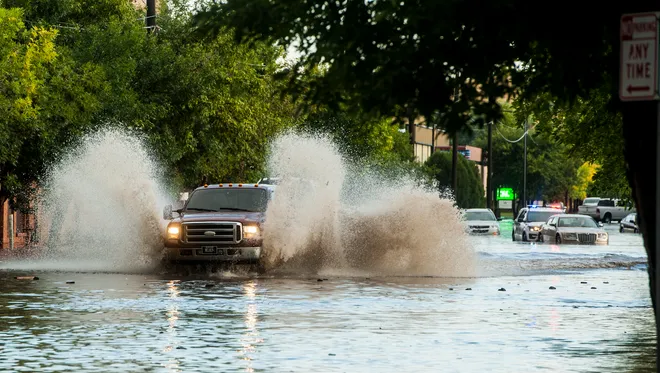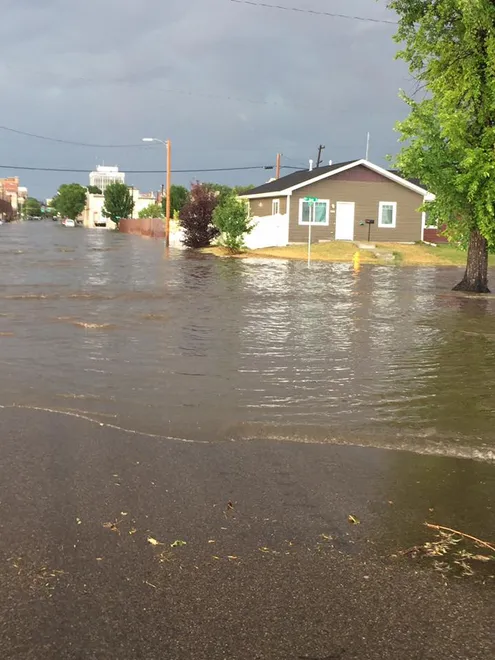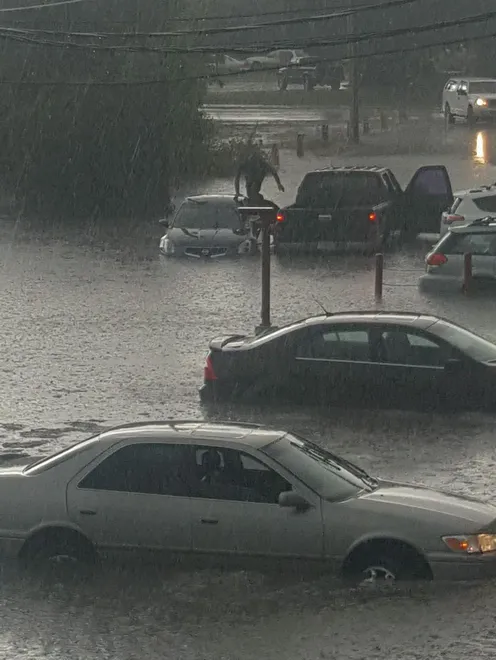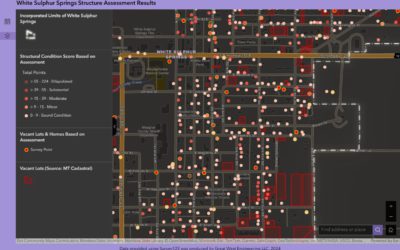
Flooding in Great Falls, MT – Photos courtesy of The Great Falls Tribune
Stormwater planning and management often falls behind as a priority for communities. This is understandable with the ever-present demands for providing clean drinking water and adequate collection and treatment of wastewater, along with many other competing needs for resources to keep a community running. However, a lack of stormwater management can ultimately lead to risks and economic impacts that should not be overlooked. With climate variability, increasing development, and aging infrastructure, public entities face growing challenges in managing stormwater effectively. Risks from stormwater flows go beyond just minor nuisances and include:
- Damage to public infrastructure, including streets, utilities and buildings
- Damage to private property and residences
- Impacts to water quality, including co-mingling with untreated wastewater and chemicals
- Impacts on access for emergency services
- Erosion and sediment transport
- In extreme instances, threat to life and safety

Flooding in Great Falls, MT – Photos courtesy of The Great Falls Tribune
Why Plan?
Knowing your stormwater infrastructure isn’t just about preventing puddles — it’s about risk reduction. Proactive planning can be the first step in facilitating the following:
- Reduced emergency repairs and long-term costs
- Reduced property damage
- Improvement of water quality and public health
- Supports grant and funding applications
- Compliance with regulatory requirements
Investing in stormwater planning sets the groundwork for ensuring that your infrastructure is ready for the next big storm event.
Types of Stormwater Planning
Stormwater planning typically consists of either Master Plans or Preliminary Engineering Reports (PERs). These types of planning and the resulting documents are similar in nature but serve different purposes depending on the community’s needs and funding strategy.
A Stormwater Master Plan is a comprehensive study of a community’s entire stormwater system. It often includes:
- Inventory and mapping of system components (e.g., pipes, manholes, catch basins, ditches, culverts, treatment structures, and detention/retention ponds)
- Identification of deficiencies, often using computer modeling and field inspections
- Identification of future development areas and associated runoff impacts
- Evaluation of improvement alternatives and associated cost estimates
- Prioritization of improvements based on community input, risk levels, cost, and growth potential
- Development of a Capital Improvement Plan (CIP)
- Preparation of a final report summarizing all findings and recommendations
A Stormwater PER has many of the same components as a Master Plan but is typically prepared in conjunction with grant and loan applications for a specific project. The format may vary slightly by state agency but generally includes:
- Executive summary
- Planning area overview
- Summary of existing facilities
- Description of system needs
- Evaluation of alternatives and selection of a preferred solution
- Detailed design concepts, project costs, schedule, and funding strategy
- Final recommendations and conclusions
GIS Integration
Geographic Information Systems (GIS) are transforming the way communities manage their utility systems. With GIS, communities can:
- Maintain a database inventory of stormwater pipes, manholes, catch basins, ditches, detention/retention ponds, treatment structures and outfalls
- Overlay floodplain maps and land use layers to assess areas of risk
- Track ages of infrastructure components and maintenance history
- Prioritize improvements based on real data
GIS also helps facilitate communication of stormwater needs with engineers, stakeholders, developers and regulatory agencies and supports long-term asset management.
Great West Engineering has assisted communities throughout the northwest United States with their stormwater needs for decades. Our team understands that no two communities are the same, which is why we tailor each effort to local conditions, risks, and priorities. The following case study highlights how a phased, data-driven approach to stormwater planning has helped one community manage recurring flooding challenges and position itself for long-term success.

Flooding in Great Falls, MT – Photos courtesy of The Great Falls Tribune
City of Great Falls Stormwater Infrastructure and Planning
The reoccurrence of high intensity rainfall events in the City of Great Falls triggered a series of stormwater studies. The City hired Great West Engineering to complete the studies, which ultimately culminated in a city-wide stormwater master plan. The high intensity storms resulted in flood damage, particularly in the Downtown area. The first studies consisted of analysis and planning for the Downtown drainage basin and an adjacent basin that influences the Downtown area. The initial studies facilitated the development of a four-phased implementation plan for storm drain improvements in the Downtown portion of the City. Phase 1 has been fully constructed, and Phase 2 is currently under construction. The final two phases are entering the design stage. Following the initial studies, Great West was hired by the City to complete the city-wide stormwater master plan. The master plan resulted in a roadmap for implementation of seventeen high priority projects over the next 10 to 15 years.
Great West Engineering has the experience and expertise necessary to guide our clients through the stormwater planning process. Contact us to learn more about how our engineers, planners, and community development team can assist your community.
LATEST NEWS
Kasey Ketterling Joins The Great West Engineering Team
We are pleased to announce that Kasey Ketterling has joined the Great West Engineering team in our Boise office. This marks an exciting opportunity for the local office as we continue to grow our municipal expertise by adding an experienced professional engineer and...
Beyond the Blueprint: How GIS Enhances Engineering & Planning Solutions
Geographic Information Systems (GIS) have become an essential tool for communities striving to make smarter, data-driven decisions. From infrastructure planning to public engagement, GIS provides a dynamic way to visualize, analyze, and manage data across a wide range...
Yearly ROSE Award Winners
At Great West Engineering, we take pride in recognizing the dedication and hard work of our team. Each year, the Recognition of Special Effort (ROSE) award honors employees who go above and beyond—those who step up, make a difference, and inspire those around them....



